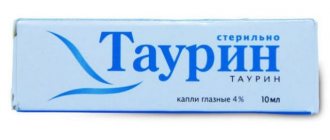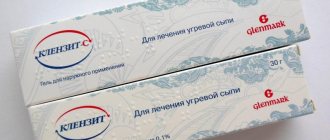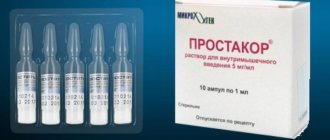pharmachologic effect
Progestogen for external use. The active component of the drug is progesterone.
The action of progesterone is based on blocking estrogen receptors, which improves fluid absorption from tissues and reduces compression of the milk ducts, as well as blocking prolactin receptors in breast tissue, which leads to a decrease in lactopoiesis.
Local use of the drug, creating a high concentration of progesterone in the area of application, does not have a systemic effect and avoids unwanted side effects.
The mechanism of action of Progestogel is based on increasing the concentration of progesterone in breast tissue.
In addition, the transdermal method of administering gestagen also makes it possible to influence the condition of the glandular epithelium and vascular network, as a result of which capillary permeability decreases, the degree of swelling of the breast tissue decreases, and the symptoms of mastalgia disappear.
Progestogel gel for the treatment of mastopathy price reviews
The instructions for use indicate the active ingredient - progesterone at a concentration of 1%, which means 1 gram in 100 grams of the drug.
Progestogel is produced in the form of a colorless, translucent gel for external use, which is contained in 80 gram aluminum tubes.
The cardboard package comes with a dosing applicator, which allows you to use the product in sufficient quantities.
Excipients necessary to give the gel a convenient consumer consistency: thickeners (carbomer 980), emulsifiers (triethanolamine), solvents (octyldodecanol), macrogol glyceryl hydroxystearate, ethanol 96%, purified water. The presence of ethyl alcohol gives the drug a characteristic odor, which quickly evaporates after applying the gel to the skin.
Progestogel is used for the following indications:
- mastalgia or mastodynia - painful, uncomfortable sensations in the mammary glands, swelling and swelling, increased sensitivity when touched, which leads to severe physiological and psychological discomfort, disrupts the usual routine and can provoke signs of stress;
- diffuse fibrocystic mastopathy is a pathological condition in which fibrous and cystic lumps grow and pain in the chest area continues constantly.
The dosage of the drug depends on the patient’s condition and is determined by the following standards: 1 portion in an applicator (2.5 g of gel) is applied to the skin in the mammary glands until completely absorbed, 1-2 times a day daily or in the 2nd phase of the menstrual cycle (starting from the 16th day before the onset of menstruation).
In combination with combined hormonal contraceptives, the effect of the drug may be slightly enhanced. Since the drug has reduced systemic absorption (absorption by the body), overdose practically does not occur. The drug is applied to the skin without rubbing or pressing on the mammary glands; after applying the gel, do not expose it to direct sunlight.
Progesterone in Progestogel acts in this way: it blocks estrogen receptors, as a result of which the removal of fluid from muscle and fat tissue is accelerated and pressure on the milk ducts is reduced. In addition, progesterone blocks prolactin receptors in the mammary glands, therefore the process of lactopoiesis (maintenance of lactation) slows down.
Progestogel gel 1% 80g
After applying Progestogel, the concentration of progesterone inside the mammary gland increases and the activity of estrogen receptors decreases against the background of the production of enzymes that convert estradiols into less active estrones (and then into biologically inactive estrone sulfate). As a result, progesterone stops the spread of estrogens in breast tissue.
Progesterone also exhibits a slight natriuretic effect and leads to increased excretion of sodium ions in the urine. This occurs because tubular reabsorption (the process of reverse release of water from urine located in the lumen of the tubules into the lymph and bloodstream) slows down.
Cellular filtration increases, which promotes the removal of accumulated fluid during the functioning of the secretory system in the mammary glands. This helps to cope with pain caused by mastalgia or mastodynia (pain in the chest).
Why are breasts shrinking?
The transdermal method of using the drug (through the surface of the skin) has an effect on the glandular epithelium and blood vessels, which reduces the permeability of capillary walls, reduces swelling and swelling, and relieves pain. With this method of use, the drug immediately enters the mammary glands, without affecting the liver and leaving no negative consequences.
Since the drug is used locally, that is, only in the area where symptoms occur, this allows the required concentration to be delivered without systemic exposure and prevent the occurrence of side effects.
Side effects
During use of the drug, some side effects may occur:
- allergic reactions - erythema (redness of the skin associated with dilation of capillaries) at the site of application of the gel, swelling of the lower face and neck, fever, headaches, nausea and vomiting;
- in the genitourinary system – metrorrhagia (bleeding between menstruation), “hot” flushes, decreased libido.
For certain categories of patients, there are special instructions when using the drug Progestogel.
- During pregnancy and lactation, the effect of this drug has not been sufficiently studied. It is allowed to use the drug in a situation where the expected beneficial properties exceed the possible negative consequences for the mother and child.
- In case of impaired liver function, the drug is used cautiously in case of liver failure with damage to liver cells and weakening of the filtering function.
- In case of impaired renal function - with caution in case of renal failure with difficulty in water-electrolyte metabolism and other functions.
Special instructions apply to various periods of reproductive age: during puberty, during the use of oral contraceptives, with premenstrual tension syndrome, and with the onset of menopause. All individual aspects are identified during the examination and prescription of therapy by a medical specialist.
The effect of the drug on the ability to drive mechanical vehicles and vehicles has not been identified; such tests have not been carried out.
Contraindications
The drug is used with caution in the post-abortion period, during ectopic pregnancy, and in various pathologies of intrauterine development of the fetus.
For such diseases: neurological diseases (migraine, epilepsy), depression and mental disorders.
The drug Progestogel is produced by Belgium and Laboratory Bezen International, France. The cost in pharmacy chains ranges from 600-800 rubles.
The drug has no direct analogues in composition and method of use.
Similar drugs with the active ingredient progesterone differ in price, but we advise you not to replace the prescribed drugs yourself and act within the framework of the therapy chosen by your doctor.
Iprozhin is an analogue of Progestogel
Analogs for the active substance (300-500 rubles):
- Iprozhin (Italfarmaco, Italy) – capsules for oral and intravaginal administration, prescribed for hormonal therapy for infertility, in combination with estrogens during the postmenopausal period;
- Prajisan (Sun Pharmaceutical Industries Ltd, India) – capsules for oral and intravaginal use, used for secondary amenorrhea, fibrocystic mastopathy, to support the luteal phase before in vitro fertilization;
- Utrozhestan (“Besen Healthcare SA”, Belgium) – capsules for oral use, used for infertility, premenstrual tension, and for the prevention of neoplasms in the genitourinary system.
Crinon (Fleet Laboratories Limited, UK or Merck Serono, Switzerland) is the most expensive analogue from 1500 rubles, vaginal gel, prescribed for diseases associated with progesterone deficiency.
Drugs
Natural progesterone. The drug is most often produced in ampoules (oily transparent solution), it contains from 10 to 25% of the active substance. It is administered intramuscularly or subcutaneously. Before use, the solution in the ampoule is placed in warm water for several minutes so that the temperature of the medicine is closer to body temperature and the composition of the solution becomes more liquid.
The drug is prescribed to pregnant women to prevent unwanted termination of pregnancy or to prevent miscarriage - 5 ml per day. When treating amenorrhea and ovarian dysfunction, the medicine is prescribed approximately 1 ml per day.
Gel Krinon (Krinon gel). Indications for use: low progesterone levels; use during pregnancy is allowed. The drug is intended for vaginal use, is considered one of the most highly effective drugs, contains about 80% progesterone.
The description of the use of the drug Crinon gel states that it is so effective that its one-time administration allows you to raise and stabilize progesterone levels for up to 2-3 days. In practice, the gel and its analogues are prescribed for use once a day, on the 20th day of the monthly cycle or in the first month of pregnancy.
Duphaston. Duphaston group drugs are artificial analogues of natural progesterone. The drug is quite safe, therefore it has indications for use during pregnancy to treat unwanted abortion. For infertility, duphaston is used in the same dosage twice a day for 1 month, after which the dosage is increased by 1.5 times.
Utrozhestan. The drug is available in capsules of 50-250 mg for oral administration or as suppositories for vaginal use. Indications for use allow treatment during the first 4 weeks of pregnancy at risk of unwanted termination of pregnancy or prevention of miscarriage.
Ingesta. A drug for intramuscular use used in the treatment of delays and menstrual irregularities. It is used for 2 weeks, one injection per day, after which the dosage is increased by 1.5 times.
Many of the drugs containing progesterone, when purchased from a pharmacy chain, do not require a prescription, but self-treatment without consultation with a specialist is unacceptable.
Instructions for use
Progesterone-based gel is prescribed by a gynecologist or mammologist. Without the recommendation of a specialist, you cannot use a hormonal drug: in some forms of mastopathy, the appearance of nodules, excess progesterone can harm the body.
It is important to use the progesterone-containing drug Progestogel on the days of the cycle determined by your doctor. Depending on the type and stage of the pathology, the strength of the painful manifestations, treatment of the mammary glands, according to the instructions, is carried out in the second (luteal) phase, starting from day 16 to 25, or the product is applied daily, including the period of menstrual bleeding. The period of therapy is adjusted by a mammologist or gynecologist.
The optimal duration of treatment of the mammary glands is up to three cycles. If indicated, the doctor may prescribe a repeat course. It is forbidden to use the drug Progestogel longer than the time specified by the specialist.
How to apply the drug correctly
To achieve maximum therapeutic effect, you must follow the instructions:
- Before first use, open the container and use a punch (inside the cork) to pierce the protective layer;
- take the dispenser applicator and squeeze the product over its ruler. It is important that the length of the strip of progesterone-containing gel coincides with the notch on the ruler;
- To treat one breast, 2.5 g of local product is enough. Gently distribute a single dose over the surface of the gland using an applicator, wait until the composition is absorbed;
- Breast treatment should be carried out 1 or 2 times a day. One tube contains 30 doses of Progestogel gel;
- During the course of therapy, you need to ensure that the sun's rays do not fall on the treatment area: visiting the beach and solarium is prohibited. In the summer, a woman should wear light clothing that covers the décolleté, shoulders, and armpits to prevent exposure to the sun.
During treatment, the mammary glands should not be massaged. There is also no need to rub Progestogel gel into painful areas: the movements are light, without pressure.
Contraindications
- nodular forms of fibrocystic mastopathy;
- tumors (tumor-like formations) of the mammary glands of unknown etiology;
- monotherapy for breast cancer;
- monotherapy for genital cancer;
- II and III trimesters of pregnancy;
- individual hypersensitivity to the components of the drug.
The drug should be used with caution in case of liver failure, renal failure, bronchial asthma, epilepsy, migraine, depression, hyperlipoproteinemia, ectopic pregnancy, abortion in progress, a tendency to thrombosis, acute forms of phlebitis or thromboembolic diseases, bleeding of unknown etiology from the vagina; porphyria, arterial hypertension, diabetes mellitus.
special instructions
Progestogel® can be used for mastodynia associated with taking oral contraceptives, puberty, premenopause, and premenstrual tension syndrome.
The drug should be applied to the skin of the mammary gland using a dispenser applicator, without rubbing or massaging the mammary glands.
After applying the cream, you should avoid direct sunlight.
Impact on the ability to drive vehicles and operate machinery
Studies have not been conducted to determine the possible effect of the drug on the ability to drive a car or the ability to operate machinery.
Release form, composition and packaging
Gel for external use 1% colorless, translucent, slightly opalescent, without visible particles, with the smell of alcohol.
| 1 dose | 1 tube | |
| natural micronized progesterone | 25 mg | 800 mg |
Excipients: octyldodecanol, carbomer 980, macrogol glyceryl hydroxystearate (polyoxyl hydrogenated castor oil), trolamine (triethanolamine), ethanol, purified water.
80 g - aluminum tubes (1) complete with applicator-dispenser - cardboard packs.
Therapy
Modern medicine these days has a large number of progesterone preparations, and they all have the same goal - replacing the missing progesterone hormones to increase their levels in the body. The drugs are available in the following forms:
- pills,
- gel,
- candles,
- injection.
The preparations often contain an additional female hormone, estrogen, which stimulates the body’s own production of progesterone. Progesterone and its analogues are prescribed after an ultrasound examination of the thyroid gland and urine and blood tests. As a rule, tests are done several times, at different periods of the menstrual cycle.
The dosage and frequency of taking medications (solution, gel, suppositories) often varies throughout the course of therapy depending on the blood serum tests performed. If hormone levels do not increase within 1-2 weeks, the dosage is gradually increased and vice versa. The decision to discontinue therapy is made after stabilization of progesterone concentrations to normal levels for 1 month without taking medications.
Side effects
It is important to strictly follow the specialist’s recommendations for the use of this medicine. Otherwise, the gel may cause the development of the following side effects:
- soreness, tuberosity of the mammary glands;
- rushes of blood to the site of application of the gel;
- decreased libido (sexual desire);
- metrorrhagia (excessive uterine bleeding between menstruation);
- allergic manifestations (skin irritation, swelling of the neck and lips);
- nausea;
- feverish condition.








